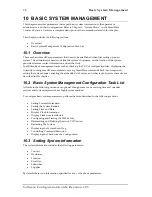
74
Configuration File Handling
Command
Purpose
Step 1
node
#copy running-config tftp://
node-ip-
adress/current-config
Uploads the current running configuration
as file
current-config
to the TFTP server at
address
node-ip-address
. This progress is
visualized with a counter, counting up
from 0 to 100% according to the
downloaded amount of the file size. If the
upload should fail an error message “%
FileTransfer - Put failed” is displayed.
Step 2
Offline editing of the configuration file
current-config
on the TFTP server using any
regular text editor.
Step 3
node
#copy tftp://
node-ip-adress
/
current-
config
nvram:
startup-config
Downloads the modified configuration file
current-config
from the TFTP server at
address
node-ip-address
into the persistent
memory region
nvram:
using the name
startup-config
. This progress is visualized
with a counter, counting up from 0 to 100%
according to the downloaded amount of
the file size. If the download should fail an
error message “% FileTransfer - Get failed”
is displayed.
Step 4
node
#reload
Restarts the system
Example: Modifying the Running Configuration Offline
The following example shows the commands used to upload the running configuration from the
SmartNode to the file
current-config
on a TFTP server at IP address 172.16.36.80. The uploaded
configuration file will be written into the root directory specified by the TFTP server settings, and
overwrites any existing file with the same name. Read your TFTP server manual to get a thorough
understanding of its behavior. After this the configuration file is available for offline editing on the
TFTP server. Following the modified configuration file
current-config
is downloaded from the TFTP
server, at IP address 172.16.36.80,
to the SmartNode’s persistent memory region
nvram:
using the
name
startup-config
. Finally the SmartNode has to be restarted.
SN#
copy running-config tftp://172.16.36.80/user/current-config
Upload...100%
At this point in time the offline editing of the configuration file
current-config
on the TFTP server
takes place.
SN#
copy tftp://172.16.36.80/user/ current-config nvram:startup-config
Download...100%
SN#
reload
Press 'yes' to restart, 'no' to cancel :
yes
The system is going down
9.12 Deleting a Specified Configuration
Software Configuration Guide, Revision 1.03
You can delete configuration files from the SmartNode flash memory region
nvram:
.






























